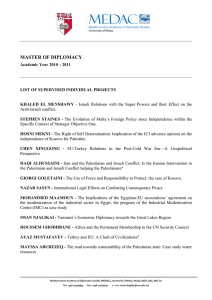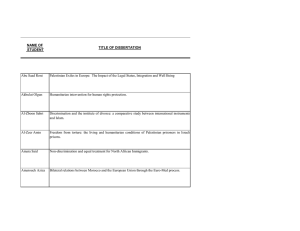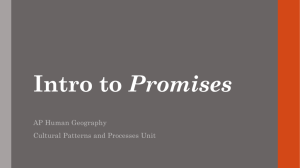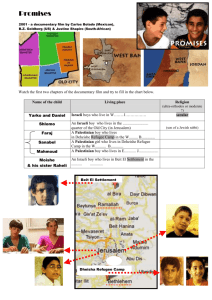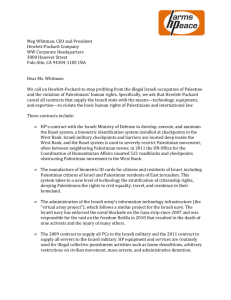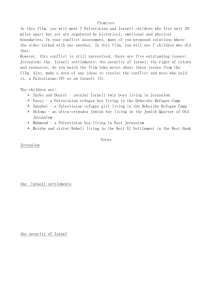Universal Periodic Review – Israel
advertisement
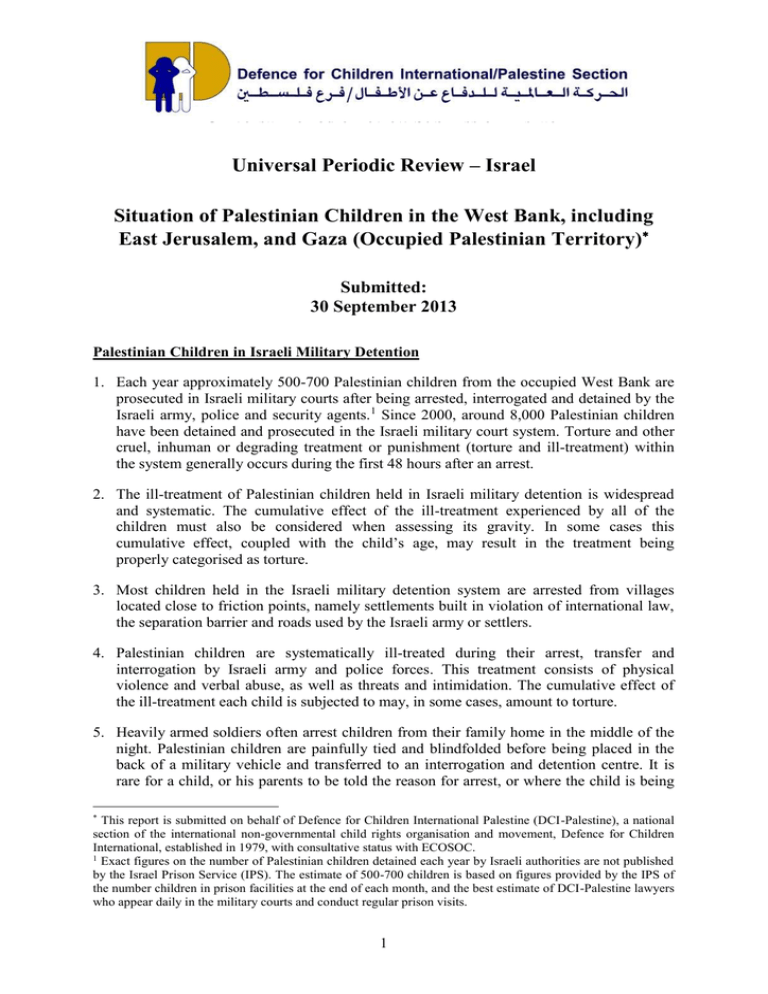
Universal Periodic Review Submission - Israel Universal Periodic Review – Israel Situation of Palestinian Children in the West Bank, including East Jerusalem, and Gaza (Occupied Palestinian Territory) Submitted: 30 September 2013 Palestinian Children in Israeli Military Detention 1. Each year approximately 500-700 Palestinian children from the occupied West Bank are prosecuted in Israeli military courts after being arrested, interrogated and detained by the Israeli army, police and security agents.1 Since 2000, around 8,000 Palestinian children have been detained and prosecuted in the Israeli military court system. Torture and other cruel, inhuman or degrading treatment or punishment (torture and ill-treatment) within the system generally occurs during the first 48 hours after an arrest. 2. The ill-treatment of Palestinian children held in Israeli military detention is widespread and systematic. The cumulative effect of the ill-treatment experienced by all of the children must also be considered when assessing its gravity. In some cases this cumulative effect, coupled with the child’s age, may result in the treatment being properly categorised as torture. 3. Most children held in the Israeli military detention system are arrested from villages located close to friction points, namely settlements built in violation of international law, the separation barrier and roads used by the Israeli army or settlers. 4. Palestinian children are systematically ill-treated during their arrest, transfer and interrogation by Israeli army and police forces. This treatment consists of physical violence and verbal abuse, as well as threats and intimidation. The cumulative effect of the ill-treatment each child is subjected to may, in some cases, amount to torture. 5. Heavily armed soldiers often arrest children from their family home in the middle of the night. Palestinian children are painfully tied and blindfolded before being placed in the back of a military vehicle and transferred to an interrogation and detention centre. It is rare for a child, or his parents to be told the reason for arrest, or where the child is being * This report is submitted on behalf of Defence for Children International Palestine (DCI-Palestine), a national section of the international non-governmental child rights organisation and movement, Defence for Children International, established in 1979, with consultative status with ECOSOC. 1 Exact figures on the number of Palestinian children detained each year by Israeli authorities are not published by the Israel Prison Service (IPS). The estimate of 500-700 children is based on figures provided by the IPS of the number children in prison facilities at the end of each month, and the best estimate of DCI-Palestine lawyers who appear daily in the military courts and conduct regular prison visits. 1 taken. The arrest and transfer process is frequently accompanied by both physical and verbal abuse. 6. On arrival at the interrogation and detention centre, children are denied access to counsel prior to interrogations and are questioned without the presence of a lawyer or family member. There is generally no provision for the audio-visual recording of interrogations as a means of independent oversight. Few children are properly informed of their right to silence. 7. Children are frequently threatened and physically assaulted during interrogation often resulting in the provision of a coerced confession, or the signing of documents that the child is not given a chance to read or understand. In some cases, children are shown or sign a statement in Hebrew, a language they do not understand. 8. Following interrogation, children are brought before an Israeli military court, which has jurisdiction over children as young as 12 years old.2 In the overwhelming majority of cases bail is denied and an order for detention until the end of the legal process will be made. Most children plead guilty, whether the offence was committed or not, as this is the quickest way out of the system. 9. During 2012, Defence for Children International Palestine (DCI-Palestine) dealt with 144 total cases involving child prisoners. Of these cases, DCI-Palestine referred a total of 22 cases to other lawyers. Out of the remaining 122 children that DCI-Palestine represented in Israeli military courts, 89 children (73 percent) where charged and 33 children (27 percent) were not prosecuted in the military court system. Of the 89 children who were charged, 87 children (98 percent) were convicted, including 17 children (19 percent) released on bail. Only 2 children (2.2 percent) that faced charges were acquitted. 10. Between 50–60 percent of Palestinian child prisoners are held at prisons and detention facilities inside Israel in violation of Article 76 of the Fourth Geneva Convention, which prohibits transfers out of an occupied territory. The practical consequences of this violation is that many children receive infrequent, or no family visits, due to the length of time it takes to obtain a permit, or because permits are denied for unspecified “security” reasons. Further, Palestinian children are not permitted use the telephone while in detention. 11. At least 21 children were held in solitary confinement while being subjected to repeated and prolonged interrogations, with the apparent purpose of obtaining a confession. During these interrogations, children reported being forced to sit in a low metal chair secured to the floor of the room, with their hands and feet cuffed to the chair, often for several hours. 12. Information collected by DCI-Palestine suggests that amendments to Israeli military law establishing a juvenile military court, raising the age of majority from 16 to 18 and improving notification requirements upon arrest have had only a marginal impact on the situation facing Palestinian children prosecuted under Israeli military law. These amendments have done almost nothing to address the widespread and systematic illtreatment of Palestinian children during arrest, transfer or interrogation. 2 Military Order 1651, §§ 1 and 191. 2 13. Below are common violations raised in the affidavits collected by DCI-Palestine during 2012: Table 1: Common complaints and areas of concern between 1 January to 31 December 2012 West Bank & West bank East Jerusalem East Jerusalem Complaints and areas of concern No. of No. of No. of % % % Cases Cases Cases Total affidavits collected 139 100.0% 108 100.0% 31 100.0% 1 Hand ties 134 96.4% 105 97.2% 29 93.5% 2 No lawyer present during interrogation 134 96.4% 107 99.1% 27 87.1% 3 Not informed of rights 133 95.7% 103 95.4% 30 96.8% 4 Blindfolds 130 93.5% 103 95.4% 27 87.1% 5 Not informed of reason for arrest 118 84.9% 88 81.5% 30 96.8% 6 Physical violence 110 79.1% 80 74.1% 30 96.8% 7 Verbal abuse, humiliation and intimidation 101 72.7% 73 67.6% 28 90.3% 8 Strip searched 99 71.2% 96 88.9% 3 9.7% 9 Denial of adequate food and water 95 68.3% 88 81.5% 7 22.6% 10 Threats or inducement 79 56.8% 61 56.5% 18 58.1% 11 Denial of access the toilet 77 55.4% 72 66.7% 5 16.1% 12 Night arrest 70 50.4% 49 45.4% 21 67.7% 13 Position abuse 54 38.8% 45 41.7% 9 29.0% 14 Transfer on vehicle floor 52 37.4% 49 45.4% 3 9.7% 15 Shown or signed paper in Hebrew 45 32.4% 17 15.7% 28 90.3% 16 Solitary confinement for more than two days 21 15.1% 21 19.4% 0 0.0% 17 Detained with adults 9 6.5% 8 7.4% 1 3.2% 18 Attempted recruitment 4 2.9% 4 3.7% 0 0.0% 19 Threat of sexual assault 2 1.4% 2 1.9% 0 0.0% 20 Electric shock 1 0.7% 0 0.0% 1 3.2% Number of Palestinian children in Israeli military detention 14. Currently, the average number of Palestinian children in Israeli military detention at the end of each month is 221 during 2013. The data below is compiled by DCI-Palestine from information obtained from the Israeli Prison Service (IPS) and from Israeli army temporary detention facilities. The figures are not cumulative, but a snapshot of the number of children in detention at the end of each month. Table 2: Total number of Palestinian children in Israeli detention at the end of each month Jan Feb Mar Apr May Jun Jul Aug Sep Oct Nov Dec Aver. 2009 389 423 420 391 346 355 342 339 326 325 306 305 355 2010 318 343 342 335 305 291 284 286 269 256 228 213 289 2011 222 221 226 220 211 209 202 180 164 150 161 135 192 2012 170 187 206 220 234 221 211 195 189 164 178 195 198 2013 223 236 238 238 223 193 195 - - - - - 221 3 15. Currently, an average of 40 children between 12 and 15 years old are in Israeli military detention at the end of each month in 2013. Table 3: Number of young (12-15) Palestinians in Israeli detention at the end of each month Jan Feb Mar Apr May Jun Jul Aug Sep Oct Nov Dec Aver. 2009 50 54 53 47 39 47 42 39 40 44 41 42 44 2010 44 41 39 32 25 23 18 20 32 34 32 30 31 2011 34 45 45 37 38 38 40 34 35 30 33 19 36 2012 26 24 31 33 39 35 34 30 28 21 21 23 29 2013 31 39 39 44 48 41 35 - - - - - 40 Recommendations Respect and enforce the principles of the protection of persons subjected to detention or imprisonment, specifically children, and implement the specific recommendations concerning the administration of juvenile justice and protection of Palestinian children living in the Occupied Palestinian Territory previously made by the Committee on the Rights of the Child and Committee Against Torture. Ensure that children living in the Occupied Palestinian Territory are for all purposes considered as children up to the age of 18 years and that they effectively benefit from the full protection under the Convention on the Rights of the Child, in particular, the provisions relating to the administration of juvenile justice. Take all necessary measures to prohibit and end the systematic ill-treatment and torture of Palestinian children in Israeli military detention. Ensure that no children are prosecuted in Israeli military courts that lack comprehensive fair trial guarantees or fail to meet juvenile justice standards in accordance with the Convention on the Rights of the Child and the International Covenant on Civil and Political Rights. Take all necessary measures to ensure that the “best interests of the child” standard is the paramount consideration in the administration of juvenile justice in the Occupied Palestinian Territory. Ensure that children accused of having committed “security offences” are only detained as a measure of last resort, in adequate conditions in accordance with their age and vulnerability and for the shortest possible period of time. Conduct independent, thorough and impartial investigations into allegations of torture and ill-treatment in accordance with international standards and obligations under international humanitarian law and international human rights law, specifically the Convention on the Rights of the Child and Convention Against Torture. Immediately remove all children from solitary confinement, ensure that the practice of using solitary confinement on children in Israeli detention facilities ceases immediately, and promptly enshrine the prohibition in law. 4 Ensure that all evidence obtained by force or coercion during an interrogation, or when a child is not properly informed of his right to silence, is excluded from evidence in the Israeli military courts. Ensure that all confessions written in Hebrew and signed or adopted by a Palestinian child are rejected and excluded as evidence by the Israeli military courts, and that judicial decisions are no longer made solely on the basis of confessions from children. Violence against Palestinian children by Israeli forces and settlers 16. Since the outbreak of the second intifada in 2000, Israeli forces are responsible for the death of at least 1,397 children in the Occupied Palestinian Territory, including at least 1,031 in the Gaza Strip, according to evidence collected by DCI-Palestine.3 At the end of 2012, during the most recent offensive in Gaza, at least 33 children were killed. Between December 2008 and January 2009, Israeli forces killed at least 353 children, including 26 kids in or near schools.4 17. During the first six months of 2013, with high numbers of demonstrations occurring throughout the West Bank, lax enforcement of the Israeli army’s open-fire regulations has led to increased violence against Palestinian civilians and has perpetuated impunity. Israeli forces are prohibited from firing rubber-coated metal bullets at women and children. Where firing rubber-coated metal bullets is allowed, police and military procedures state that they must only be fired from a distance of 50-60 meters (165–195 feet) and at the legs of people. The regulations also prohibit directly targeting demonstrators with tear-gas canisters. 18. Despite these regulations, at least 30 children have been shot and injured, including three killed, by live ammunition, rubber-coated metal bullets or tear-gas canisters since January 2013, based on DCI-Palestine documentation.5 19. While Israeli forces regulations allow the use of these weapons for crowd control in certain narrow circumstances, only a third of these cases involve children directly participating in demonstrations where clashes with Israeli forces later occurred. 20. In May 2013, the average number of civilians injured by live ammunition or rubbercoated bullets more than tripled compared to this time last year, according to the United Nations Office for the Coordination of Humanitarian Affairs (OCHA).6 21. Since January 2008, DCI-Palestine has regularly documented cases of violence against children in the West Bank and East Jerusalem where the perpetrator is an Israeli settler. Generally, cases occur in or near Palestinian neighbourhoods, villages or roads located 3 Defence for Children International Palestine, Child Fatalities, http://www.dci-palestine.org/content/childfatalities. 4 Defence for Children International Palestine & Al Mezan Centre for Human Rights, BEARING THE BRUNT AGAIN: CHILD RIGHTS VIOLATIONS DURING OPERATION CAST LEAD, http://www.dcipalestine.org/sites/default/files/bearingthebruntagain.pdf. 5 Defence for Children International Palestine, Failing to abide by own regulations Israeli soldiers inflict serious injuries, http://www.dci-palestine.org/documents/failing-abide-regulations-israeli-soldiers-inflictserious-injuries-palestinian-children. 6 United Nations Office for the Coordination of Humanitarian Affairs- OPT, Humanitarian Monitor, http://www.ochaopt.org/documents/ocha_opt_the_humanitarian_monitor_2013_05_24_english.pdf. 5 close to Israeli settlements. The nature of the violence reported by the children includes being shot at, beaten, pelted with stones and sprayed with gas. Recommendations Respect and ensure compliance with all obligations under international human rights and humanitarian law with regards to the protection of children in the Occupied Palestinian Territory. Take all necessary measures to prevent further incidents of excessive use of force, and in particular review and enforce all regulations on the use of live ammunitions, rubber-coated metal bullets and tear gas canisters by Israeli forces and police in the Occupied Palestinian Territory. Take all necessary measures to protect children in the Occupied Palestinian Territory from harassment, intimidation and violence by ensuring that the settlers and Israeli forces are held accountable. Use of Palestinian children as human shields 22. Since 2004, DCI-Palestine has documented 21 cases of Israeli forces using Palestinian children as human shields. In breach of Israeli domestic law and international humanitarian law, Israel has continued to use Palestinian children as human shields with near complete impunity. 23. Generally, Israeli soldiers have compelled Palestinian children living in the Occupied Palestinian Territory to search bags or homes for people, weapons or explosives; forced them to carry messages or orders to Palestinian individuals suspected of being involved in hostilities; detained them inside buildings where soldiers have taken military positions in order to prevent live fire from Palestinian fighters; and made them stand near, or walk in front of, soldiers during confrontations to literally shield them from gunfire and/or stone-throwing. 24. During 2013, in the West Bank, cases typically involve Israeli forces, armed with live ammunition, rubber-coated metal bullets and tear gas, forcing Palestinian children to walk in front of them at gunpoint with their hands raised in the air as they confront the demonstrators during clashes. Recommendations Respect and ensure compliance with all obligations under international human rights and humanitarian law with regards to the situation of children in the Occupied Palestinian Territory, prohibiting the recruitment of children and the use of human shields. Impunity for violations 25. Many Palestinian children and/or families refuse to file complaints against Israeli authorities alleging ill-treatment, torture or violence for fear of retaliation, or simply because they do not believe the system is fair or impartial. 6 26. When complaints alleging ill-treatment or violence are filed with Israeli authorities it is rare that an indictment would be issued or any type of remedy would be provided to the victim. Recommendation Conduct independent, thorough and impartial investigations into allegations of illtreatment, torture and acts of violence against Palestinian children by Israeli soldiers and settlers in accordance with international standards and obligations under international humanitarian law and international human rights law. 7
